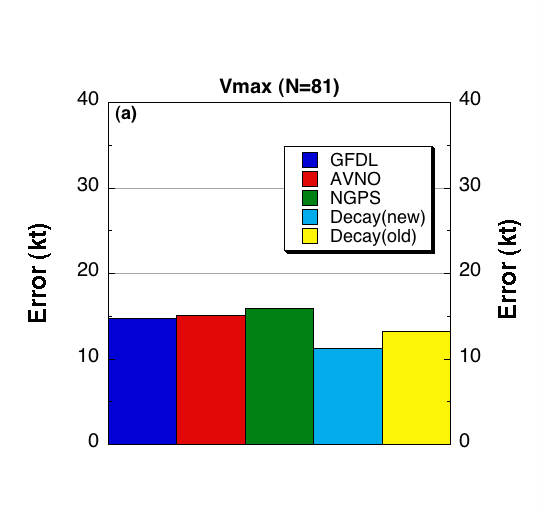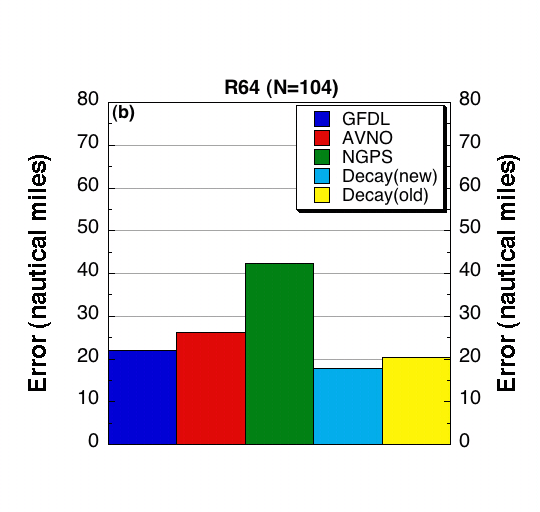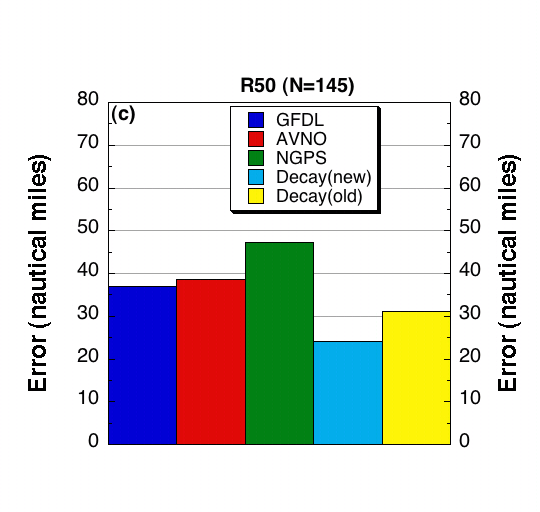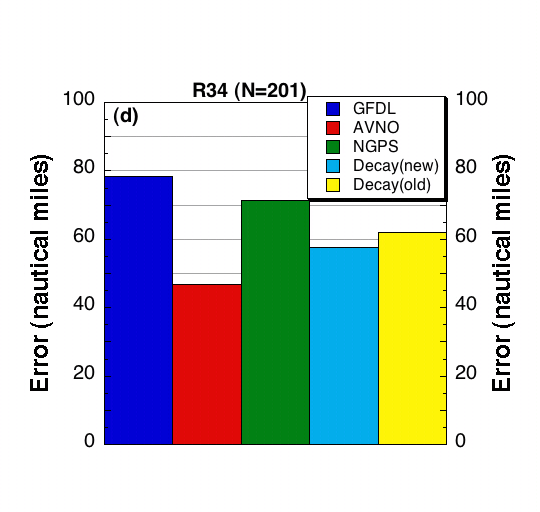|
Tropical cyclone wind radii estimation utilizing an empirical inland wind decay modelPrinciple Investigator:
John Kaplan (HRD) Methodology
The National Hurricane Center (NHC) is required to issue forecasts of the radii of 34, 50, and 64 kt winds for tropical cyclones every 6 hours as part of their forecast/advisory package. The goal of this NOAA Joint Hurricane Testbed project was to utilize the Kaplan and DeMaria decay model (Kaplan and DeMaria 1995, 2001) to provide guidance that could be used to help make such wind radii and maximum wind forecasts for systems that make landfall during the forecast period. The Kaplan and DeMaria decay model is currently used in the SHIPS model (DeMaria et. al 2005) to predict the post-landfall decrease in maximum sustained wind speed near the storm center and by the Federal Emergency Management Agency (FEMA) to estimate the maximum potential wind speeds that might be experienced at inland locations. The decay model can also be utilized to provide a 2-dimensional post-landfall wind field (Kaplan and DeMaria 1995) and this is the application that is being employed to obtain the wind radii estimates in this study. A significant goal of this project was to devise methodology that would make it possible to run the decay model utilizing the official NHC track, intensity, and storm structure forecasts. The use of the official NHC forecast is important since while there are other objective models that provide guidance on both storm size and intensity, none provide guidance that is entirely consistent with the official NHC track and intensity forecast. This is an important issue for landfalling systems since Kaplan and DeMaria (1995, 2001) have shown that the post-landfall decay of a tropical cyclone is proportional to both the intensity at landfall and the length of time that a system spends over land. Thus, both the intensity and the timing of landfall are crucial factors that help determine the changes in post-landfall wind structure. In year 1 of the project the decay model was converted from an interactive to an automated model that could be run directly using input from the ATCF file. In the second year of the project, a revised version of the decay model (DeMaria et al. 2006) that improves the prediction for systems that traverse islands and peninsulas was tested. The revised version of the original Kaplan/DeMaria decay model (Kaplan and DeMaria 1995, 2001) that better handles tropical cyclones that traverse islands and peninsulas (DeMaria et al. 2006) was tested in real-time during the 2006 hurricane season as part of the NOAA Joint Hurricane Testbed. Implementation of the updated version of the model required significant modifications to the code that was employed to run the original version. Specifically, a wind field on a cylindrical grid with an1100 km radius and 2.5 km radial and 15 deg. azimuthal spacing was generated every hour along the NHC forecast track. The shape of the wind field was determined every hour by fitting the NHC official forecasted storm structure, intensity, and storm speed along the forecast track using a modified Rankine vortex. The wind field on the cylindrical grid was then decayed for time periods when the storm was over land using the updated version of the decay model. For time periods when the storm moved back over water, the trend in the official NHC intensity forecast was employed to adjust the decayed wind field. The resultant wind field was then sampled at desired time intervals to obtain estimates of the maximum wind and the radius of 34, 50, and 64 kt winds. Results
FY06-07 Achievements
FY07-08 Milestones
DeMaria, M., J. A. Knaff, and J. Kaplan, 2006: On the decay of tropical cyclone winds crossing narrow landmasses., J. Appl. Meteor. and Clim., 45, 491-499. Kaplan, J. , and M. DeMaria, 1995: A simple empirical model for predicting the decay of tropical cyclone winds after landfall. J. Appl. Meteor., 34, 2499-2512. Kaplan, J., and M. DeMaria, 2001: On the decay of tropical cyclone winds after landfall in the New England region. J. Appl. Meteor., 40, 280-286.
Last modified: 5/4/2007 |
Links of Interest
AOML Tools & Resources
Employee Tools
| |||||||




